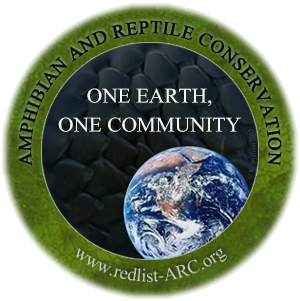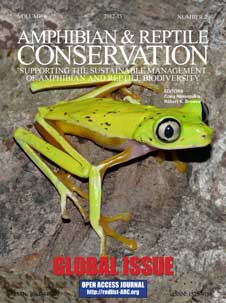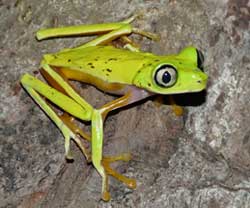|
VOLUME 6 (2) GLOBAL
ISSUE
INTERNATIONAL CHAPTER - AMPHIBIAN
AND REPTILE CONSERVATION
NOTIFICATION:
This website and its affiliates are the official Internet website portals for the Amphibian
and Reptile Conservation journal and our global conservation network. We own all
copyright, exclusive of authors copyright, produced by any proxy fraudulently presenting as
Amphibian and Reptile Conservation including the fraudulent Amphibian & Reptile
Conservation journal www.amphibian-reptile-conservation.org as published by the "Amphibian and Reptile
Conservation organisation" as an unspecified group led by Craig Hassipakis. Craig Hassipakis
has a long and dismal history of fraudulent activities, including recently committing perjury
in an attack on our global conservation network, as we document see Internet Fraud. The Middle East Chapter of Amphibian and Reptile
Conservation presents the first Issue of Amphibian and Reptile Conservation Volume 9, which
is dedicated to their publications.
For notification of the publication of
our future articles please
join our members list at MEMBERSHIP
Table of
Contents
|
New records of the Diced snake (Natrix tessellata), in
the Suez Canal zone and Sinai. Adel
A. Ibrahim. Amphibian and Reptile
Conservation 6(2):2-4(e42).
Low
resolution PDF 856K High res. PDF
1780K
|
-web.jpg) |
xxxx |
Summary: Ten
years of herpetological surveys in the Suez Canal zone revealed
that Natrix
tessellata was most common in
fresh water irrigation canals. It is recorded herein for the first time in
Port Said and Suez provinces and discovered in Sinai.
|
|
Books to
Read. 2012. Craig Hassapakis. Amphibian and Reptile Conservation 6(2):5-8(e40).
Low
resolution PDF 824K High res. PDF
1730K
|
| |
|
Summary: “Books to Read” is Amphibian and Reptile
Conservation’s recommended book section that presents and publicizes books related
to the “Sustainable Management of Amphibian and Reptile
Biodiversity” and related
topics. |
Summary:Between 2008 and 2010 we detected 53% of the
Endangered and 56% of the Critically Endangered amphibian species that have previously been
reported from the Cordillera Central of western Panama. We also found species that have not been
detected in Panama for many years and report newly discovered populations. There is a need to
create a new protected area in the Cerro Colorado area of the SerranÃa de Tabasará, where we found
15% of the Endangered and Critically Endangered amphibian species known to
Panama.
Summary: During a field survey in the Sistan region of Iran in
October 2011, habitat of Eremias acutirostris was surveyed and four specimens of the
species were collected. We report a locality situated along the road from Zabol to Doost Mohammad,
near the town of Bonjar. The fragile habitat, consist of immobile sand dunes, is situated in
proximity to an industrial zone, placing this remnant population under threat of pollution and
other anthropogenic edge effects. We call the Zabol Environmental Protection Agency to act and
insure the species’ future in Iran.
|
|
|
New
country record and range extension of Eremias suphani BaÅoÄlu &
Hellmich, 1968 from Iran. 2013. Eskandar Rastegar-Pouyani, Aziz
Avci, Yusuf KumlutaÅ, Cetin Ilgaz, Seyyed Saeed
Hosseinian Yousefkhani. 2013.
Amphibian and Reptile Conservation 6(2): 35–39.
Low resolution PDF 480K
High res. PDF
1400K
|
 |
|
Summary: Iran is located in an area that is bordered by several
mountains and contains herpetofaunal constituents from
adjacent countries such as Pakistan, Iraq, Afghanistan, and Turkey.
We surveyed several border provinces of Iran to more completely
understand the Iranian herpetofauna. During one survey in the
northwestern part of Iran we found a species of the genus Eremias that can be added to Iran’s
herpetofauna. Previously, the distribution of Eremias suphani was limited to
the Van Lake in Turkey (type locality). We compared Iranian samples
with E. suphani from Turkey
using a molecular marker (Cytochrome b) and confirmed that this species
is also present in Iran. The new record of this species
is located on the road from Firoragh to Chaldoran in the west of the
province of Azarbaijan, Iran.
|
COPYRIGHT
This work is licensed under a
Creative Commons
Attribution-NonCommercial-NoDerivs 3.0 Unported License.
Attribution — You
must attribute the work in the manner specified by the author or licensor (but not in
any way that suggests that they endorse you or your use of the work). Required
attribution for any material on this website material must include www.redlist-arc.org
Noncommercial — You may not use this work for
commercial purposes.
No Derivative Works — You may not
alter, transform, or build upon this work.
Second Party
Archiving - Subject to authors copyright, all material on this
website including articles and other PDFs is provided by Amphibian and Reptile
Conservation for private/research use. Subject to authors copyright, deposition in
public libraries or on websites without permission is
prohibited.
|



-web.jpg)






